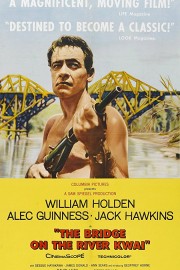The Bridge on the River Kwai
It doesn’t surprise me at all that David Lean’s “The Bridge on the River Kwai” not only won the Oscar for Best Picture in 1957, but remains a classic to this day. Aside from being a great film, it also combines two of the great formulas of war movie cinema- the POW camp movie and the mission movie. Of course, the movie is taking its cues from the novel by Pierre Boulle (Planet of the Apes), but Lean and screenwriters Carl Foreman and Michael Wilson have found a way of turning this into not just an entertaining war epic, but a fascinating study in proud men.
The film begins with Commander Shears (William Holden) in a Japanese POW camp digging graves for people who have died in the camp. He then finds himself in the infirmary, which is where he is when British soldiers are marched into the camp. Those soldiers are led by Colonel Nicholson (Alec Guinness), who finds himself immediately in a battle of wills with the camp’s commandant, Col. Saito (Sessue Hayakawa). Saito has been tasked with using his prisoners to build a bridge over a nearby river (the titular river Kwai) for the purpose of a supply track, but Nicholson refuses any of his officers for manual labor, citing the Geneva Convention. Saito does not care about those regulations, and he throws Nicholson into a sweat box for his insolence until he relents, and his officers in a holding pen. During all of this, Shears manages to escape through the jungle that surrounds the camp, but will find himself coming back to the camp when he is tasked with blowing up the bridge that Nicholson is building.
David Lean is a filmmaker I’ve known more for reputation than by seeing his films- until “Kwai,” the only movie I had seen of his is “Lawrence of Arabia.” This is a much more conventional film than “Lawrence” is, but it’s high on the list of great epic cinema, and that’s because Lean has his focus in sights in both films, and he digs into it. Based on reputation, I though “Kwai” would focus almost entirely on the construction of the bridge, sort of like Werner Herzog’s “Fitzcarraldo,” but while the bridge is entirely the focus, we see it from different perspectives in a way that is unique. Simply from a construction standpoint, the bridge becomes part of the battle of wills Nicholson and Saito engage in at the beginning of the film, with Nicholson, after being let out of the sweat box, taking over construction of the bridge as a way of showing Saito the superiority of British engineering over Japanese. He doesn’t even really think about the fact that he is helping the enemy- for him, this bridge will stand as a point of pride for the men over their captors, while Saito stands to lose much pride through his acknowledgement of British bridge building being better, along with a duty to perform ritual suicide if it is not completed on time. This is the film that won Guinness his Oscar, and it is not surprising that it was. He and Hayakawa go toe-to-toe and it’s the audience that wins in watching these characters go up against one another, and eventually come to work together in this accomplishment, and want to see it completed.
So, if Holden’s Shears escapes the camp, where does he fit in? It turns out that, when he was captured by the Japanese, he lied about his rank, so, when he is found on a river, alone, by British patrols from a nearby base, a deal is made by one of the commanding officers of the base, Major Warden (Jack Hawkins), for Shears to be handed over to the Brits for a mission to blow up the bridge Nicholson is building as part of the war effort. While I greatly enjoy the entire film, I feel like the film loses some momentum away from the prison camp, given how standard the “mission movie” material with Holden is. That being said, the movie builds to a remarkable finale that is probably one of the most impactful in movie history where Shears, Warden and another soldier (Joyce, played by Geoffrey Horne) arrive, and plant explosives, right at the moment when the first train of supplies is to make its run across the bridge. The way Lean shoots this scene, and the way it unfolds narratively, is why he was a master epic filmmaker, as he uses character to bring humanity and power to canvases as large as a bridge built during World War II. I don’t know that I will ever forget the ending of this film, and so many moments in between have the same effect.










